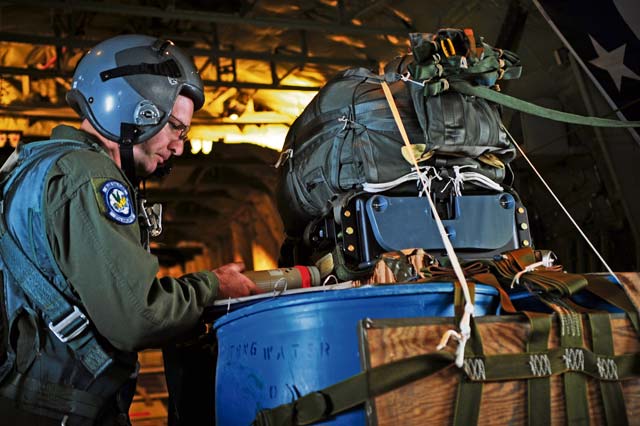
POWIDZ AIR TRANSPORT BASE, Poland — The U.S. and Polish air forces completed the first successful European airdrop utilizing specialized equipment designed to improve target accuracy and decrease potential collateral damage by the supply bundles Oct. 17 here.
Members from both air forces teamed up to effectively test the Joint Precision Airdrop System, which has the capability to put bundles on point, allowing for a reduced recovery time for personnel on the ground.
Although JPADS has been used in operations throughout the Middle East, it was recently employed for the first time in Europe, and Airmen from the 435th Contingency Response Group, the 37th Airlift Squadron and several other organizations from Ramstein were able to actively participate and see its capabilities first hand.
Airmen were able to work hand-in-hand with Polish air force members to organize, certify and successfully execute the air drop in Poland.
JPADS is an airdrop container with a GPS on it to provide the precise guidance to where the bundles need to be dropped.
“Much like the controls a jumper has while in the air, JPADS has a pulley system inside that allows it to steer,” said Army Staff Sgt. Tylor Buckingham, 5th Quartermaster parachute rigger.
Bundles without JPADS would normally float with the wind, potentially causing them to run into hills, mountains or other bundles. Now, with JPADS, bundles can be dropped at a long standoff distance to de-conflict with terrain or potential threat near the intended drop zone, allowing 435th CRG personnel to provide more timely and accurate support in European and African theaters.
“The system on each bundle has the capability to talk to one another, which prevents multiple parachutes from getting tangled together,” Buckingham said. “With all its capabilities, it makes the bundles 20 times quicker to recover.”
Without Poland’s commitment to the Aviation Detachment’s training rotations, the event couldn’t have been possible.
“I am very proud that Poland was able to assist (the) U.S. in testing this equipment,” said Lt. Col. Krzysztof Szymaniec, Polish air force C-130 squadron commander, who marked the drop a successful demonstration of the cooperation between the U.S. and Polish air forces.
The Polish land forces assisted in clearing and securing the range for the drop while the U.S. had four personnel at the site to provide drop zone control and clearance and to recover the bundle.
The first employment of this system here was dropped from 5,500 feet above sea level from a C-130J Super Hercules and landed about 20 to 30 feet from the desired point of impact.
Due to JPADS, members of the U.S. Armed Forces and its allies are able to feel that sense of relief when heading out to retrieve pallets of supplies, knowing they won’t have to go searching for them.







